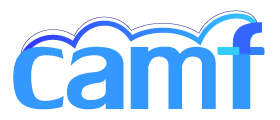General
What CAMF stands for?
CAMF stands for Cloud Application Management Framework.
How is CAMF licensed?
CAMF consists of software produced by the Eclipse Project combined with third party software from other open source projects. The software produced by the Eclipse Project is made available under the Eclipse Public License . Third party components are made available under their own licenses. The detailed licensing information can be found in the Eclipse.org Software User Agreement (notice.html) file in the root directory of the project repository. Licensing for third party components is described in about.html files in the respective subdirectories.
Is CAMF an official Eclipse project?
Yes. Since October 2014 CAMF is part of the Eclipse ecosystem as an official Eclipse Technology sub-project. You can access the project website at: http://www.eclipse.org/camf.
Which Cloud application operations are supported?
CAMF focuses on the following three core Cloud opearations:
- Application Description - Inter-operable representations of Cloud applications' structure (blueprints) with high-level depiction of service components, management operations, and inter-relationships.
- Application Deployment - Preparation and submission of descriptions to any Cloud infrastructure of preference, while enabling seamless and repeatable contextualization workflows.
- Application Monitoring - Real-time data from the underlying platform and the application itself, for fine-grained operational and performance monitoring.
What features are available?
- Vendor-Neutral Application Management - Use of open standards for promoting portability and preventing vendor lock-in.
- Automated and Streamlined Application Configuration - Applications configuration through native shell scripts or DevOps technologies.
- Application Monitoring - Interfaces for integration with monitoring systems for live application performance observations
- Elasticity Support - Policy specification that enables user-driven automatic scaling
- Intuitive GUI - Unified, drag-n-drop graphical user interface that conforms to the Eclipse UI guidelines
How CAMF achieves vendor-neutrality?
CAMF adopts the OASIS TOSCA specification for blueprinting and packaging Cloud applications in a standardized manner. TOSCA provides a vendor-neutral language for describing the topology of Cloud applications, along with their management operations. TOSCA adopts a graph-based topology representation, which includes hardware (virtual) and software components involved and their inter-relationships.
How CAMF achieves streamlined application configuration?
TOSCA provides the necessary grammar to describe management aspects of an application by means of lifecycle operations or by more complex Management Plans. For each Node, its lifecycle operations can be explicitly defined, (i.e. deploy, configure, or start an instance of the corresponding Node Type). Currently, CAMF supports lifecycle operations and particularly Node configuration through native shell scripts. In the near future, new tools will be incorporated in the framework that allow developers to import third-party, or compile their own, open-source Chef cookbooks that automate and streamline application configuration processes.
How CAMF supports resource elasticity for Cloud applications?
CAMF supports SYBL, an open-source, directive-based, elasticity requirements specification. SYBL enables developers to define fine-grained scaling policies and corresponding enforcement actions, by leveraging monitoring metrics placed at different levels of the application stack. Metrics can be obtained either from native IaaS monitoring systems or from custom metric collectors (probes) provided by the user during deployment.
Which IaaS providers are currently supported?
Currently the following Infrastructure As a Service (IaaS) providers are supported:
- Amazon Web Services EC2
- OpenStack compliant infrastructures (running IceHouse release)
- FlexiScale
- ~Okeanos
Which Cloud monitoring systems are currently supported?
CAMF is fully integrated with JCatascopia, an automated, multi-layer interoperable monitoring system for elastic Cloud environments. Besides the standard probe suite available in JCatascopia, CAMF allows application developers to define and implement custom metric collectors that adhere to JCatascopia’s modular architecture. In addition it seamlessly interfaces with Amazon CloudWatch for EC2 hosted applications.
Usage
How do I install CAMF?
What version of Eclipse does CAMF work with?
Why is Maven required for installation?
Is there any CAMF tutorial available?
Development
How can I contribute to CAMF?
To contribute you need to check-out the code from the project repository CAMF. The project uses Git for version control, therefore you need to know the Git basics to fetch the HEAD. If you are using Eclipse as your IDE (if you are here, you most probably are), the EGit team provider is the way to go.
Where is CAMF source code located?
The source code is hosted is hosted at the Eclipse foundation infrastructure. You can find it through Git here: https://git.eclipse.org/c/camf/org.eclipse.camf.git/
How do I commit my contribution back to the CAMF code repository?
We opted to introduce Gerrit in the development process right from the start so as to familiarize ourselves with code review practices. This means that every contribution, (including the ones from expert project committers) will be up for review prior to being pushed into the main repository. The CAMF Gerrit URL is the following: git://git.eclipse.org/gitroot/camf/org.eclipse.camf
How do I contact the development team?
You can do so by sending an email to the mailing list camf-dev@eclipse.org. You need to subscribe to the list beforehand here.
Support
How do I contact the user community?
You can do so by sending an email to the mailing list camf-users@eclipse.org. You need to subscribe to the list beforehand here.
How do I submit a bug I found?
You can submit a bug by visiting the Eclipse Bugzilla site for CAMF here (need to register).
How do I request a new feature?
You can request a new feature by visiting the Eclipse Bugzilla site for CAMF here (need to register).
